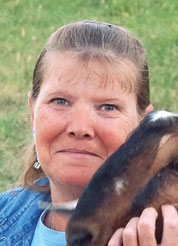
Assessing goats should begin with the reason why you are choosing to breed and raise them. Mother, Debbie and daughter, Kellie Williams, of Chelsea, Okla., made a careful selection process when they decided to raise goats on their Misty Moon Farm. “You need to learn about your animals then you can see what and when something needs done. Some people want to buy a goat to keep their lawn mowed down. Goats are not grazers; they are browsers, like a deer. A good blackberry bramble or your favorite rose bush is a five-star meal to a goat,” said Debbie.
She does believe they make wonderful pets as long as certain criteria are met. Conducting extensive research on the breed of interest will help determine whether it is ideal for a certain location. What was once cute and funny has now overgrown its space. “Too many people buy a cute little baby only to find out it grows up to weigh over 200 pounds and no longer fits in your lap,” she added.
In the selection process there are so many things that can harm goats or those who are around them. “They can knock you down without intentional harm. If they stand on their hind legs, they can surely knock you down. Dehorning is a must if they are going to be around children. Do not try and keep just one goat; they are herd animals and want/need companionship. In general, if you provide them shelter and care, then almost anyone can enjoy keeping goats,” she said.
Misty Moon Farms evolved in the spring of 2010 with two crossbred bottle bucklings and a Nubian cross doe that had two kids. “The name Misty Moon came when we purchased our first registered Boer doe. Her name was Little Star. I was setting on the patio one night and there happened to be a full moon. Star was standing on the side of the hill silhouetted by the moon light and I thought that was about the prettiest thing I have ever seen, so Misty Moon was born,” said Debbie. From that day forward they decided they wanted to raise registered stock.
They currently raise three different breeds: Boers, Nubians and Nigerian Dwarfs. “We started with the traditional colored Boer goats, a white body with a colored head and neck. In the summer of 2013 we decided to switch from the traditional Boers to dappled Boers, which very in color. Boers are primarily raised for meat. The Nubians and Nigerians are dairy breeds. We originally got the Nubians so we would have fresh goat’s milk to feed to Boer bottle babies. After we got our first fullblood Nubian, I fell in love with the breed’s gentle and curious nature and how they always wanted to be right next to me. I got into the Nigerians after buying three tiny bottle bucklings at the stockyard. I never knew goats could be so small until then. Fully grown, the maximum height of a Nigerian Dwarf buck is 23.5 inches and for a doe 22.5 inches. Even though they are little – Nigerians have a lot of attitude. There is nothing they will not do or get into,” said Kellie.
Debbie and Kellie usually breed their goats between 8 and 9 months old, depending on the body size and condition. “If we think the doe is mature enough to handle it, we will breed her instead of waiting. The gestation is five months. More specifically, it is 150-155 days for the Boers/Nubians and 145-150 days for the Nigerians. They can have anywhere from one to six kids at a time, with twins and triplets being the most common. We have had four sets of quads born here at Misty Moon. One set of boers, a set of Nubians, and two sets of Nigerians. Usually if our Boers have more than two kids we pull one, usually the smallest, and bottle raise it so that we are sure each kid gets plenty of milk. All of our dairy kids are pulled the minute they are born and are bottle raised. We have had 59 kids born so far this year; 14 Nubians, 12 Nigerians and 32 Boers,” added Kellie.
Debbie said, “We decided to raise the Nubians to help with supplemental feeding of any triplets the Boers produced. Our does typically milk 7 to 12 pounds a day by being milked twice a day. We do not keep any doe that does not produce at least 7 pounds a day; they are culled. Matty, our favorite milker will produce 14 pounds a day at peak production. She earned her milk star in the spring of 2014. A milk star is awarded for a does production and butterfat content.”
Both agree that Nubians are a very gentle, easy natured breed that is very social. “They are one of the more vocal breeds and ready to voice their opinion or demand attention,” said Debbie.
“There are not many medications labeled for goats. You have to learn very quickly with what and how to treat them with. Most veterinarians are not schooled in goats and it can be hard to find one that can treat them. I depended on good friends with vast goat knowledge to teach me the basics and learned from there. You have to be your own veterinarian, farrier, midwife, fitter and business manager. At 2 in the morning there is not the luxury of calling a vet out. You make the decision and treat it to the best of your ability. The same is true with a doe in labor. She does not have hours to wait on help; she needs immediate attention and if it is not provided you can lose the kids and even the doe,” said Debbie.
“Contrary to the old belief that a goat is a tin can eating machine that can devour anything, they can actually be quite delicate. Good shelter, a balanced feeding program, vaccinating and just plain old good care are all that is required if you want to keep them healthy and thriving,” concluded Debbie.
They have several first, second and third place awards. “I guess K&D’s MISTY MOON DV FRITO would be our favorite junior doe. She has won three Grand Champions and a Reserve Champion Award before she was 6 months old,” ended Debbie.
Debbie and Kellie are both members of ABGA (American Boer Goat Association) and ADGA (American Dairy Goat Association).







